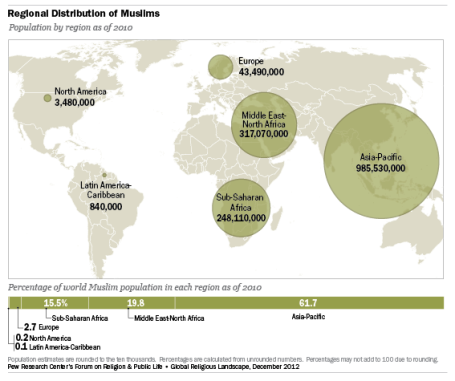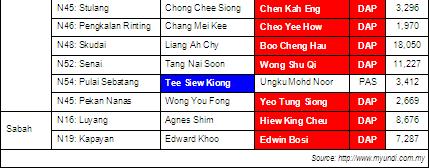Article credit to 'http://helenang.wordpress.com/'
click here for original article
In half of the world’s Muslim-majority countries (24 countries out of 48), the non-Muslim population is under 5 percent — see table below .
Most of these 24 Muslim countries have 98 to 99 percent followers of Islam. There are only one to two percent religious minorities in the top dozen Muslim countries, including Turkey which had applied to be a member of the European Union.
BELOW: Muslim-majority countries as at end-2010
More Southeast Asian Muslims than Arab Muslims
Contrary to popular belief, it is not the Middle Eastern countries that have the highest Muslim populations percentage-wise.
In absolute numbers as well, there are three times more Muslims living in the Asia-Pacific than there are Arab Muslims (see bar chart below).
Indonesia, the world’s biggest Muslim country, has 209 million followers of Islam.
Indian Muslims are most numerous in Islam
The United Arab Emirates, for example, has a 76.9 percent Muslim population (5.8 million) while Kuwait’s is 74.1 percent /2.0 million, Bahrain’s 70.3 percent /890,000 and Qatar’s 67.7 percent /1.2 million.
These small Arab countries only have between two-thirds and three-quarters adherents of Islam as a total of their resident population.
In the wake of the oil boom, the rich Arab countries have been importing foreign labour most extensively. The Filipinos, Nepalese and other Christian and Hindu expats working in the Middle East have diluted the Arab Muslim populations.
Even Saudi Arabia has “only” 93.0 percent Muslims in its population compared to the Indian sub-continent countries Afghanistan (more than 99.0%) and Pakistan (96.4%).
India, although a Hindu-majority country, has 176 million Muslims.
Mixed fortunes of the ‘stan’ states
Altogether 30 countries have a population of 90 percent and above Muslims.
The “stan” countries are all Islam — Uzbekistan, Tajikistan, Turkmenistan, Pakistan, Afghanistan, Kyrgyzstan, Kazakhstan … and don’t forget Kelantanistan too.
The most Islam-saturated countries are those in the northern belt of the African continent — Tunisia (>99.0%), Morocco (>99.0%), Niger (98.4%), Algeria (97.9%), Libya (96.6%).
It is not at all reassuring that Somalia, dubbed “the most failed state in the world” according to the annual ranking by Foreign Policy and the Global Fund for Peace, is more than 99 percent Muslim and an Islamic state that practices hudud.
- No.1 — Somalia (>99.0% Muslim)
- No.3 — Sudan (90.7% Muslim)
- No.5 — Chad (55.3% Muslim)
- No.6 — Yemen (>99.0% Muslim)
- No.7 — Afghanistan (>99.0% Muslim)
Half of the Top Ten failed states of the world are Muslim majority countries, and three of them are above 99.0 percent Muslim.
.
PIE CHART: Global Religion Share (2010)
Bishop Paul Tan heaps praise on PAS’s Mujahid
“He’s like St Francis of Assisi, truly a channel of peace, bringing consolation where there is loss, understanding where there is injury, a much needed figure indeed in our fractious times,” opined Bishop Paul Tan.
“St Francis is a 12th century figure in Catholic folklore, revered for his respectfor the environment, his practice of evangelical poverty, and his outreach to Muslims during the time of the Crusades.”
(Bold emphasis this blogger’s)
The above two paragraphs are excerpted from Netto’s Malaysiakini article.
What Netto omitted to mention, however, when talking about “his outreach to Muslims during the time of the Crusades” is that St Francis of Assisi had tried to convert Malik-al-Kamil, the sultan of Egypt to Christianity.
The evangelistas are ALWAYS! doing that — out to convert everybody.
“Ratcheting tensions” between Muslims and Christians
Netto also described Mujahid Yusof Rawa, the PAS National Unity bureau chief, as a “leading light in … forging dialogue between Muslims and Christian groups at a time of ratcheting tensions between the two communities”.
Inter-religious violence is merely something what happens elsewhere around the world’s conflict zones.

The Muslim dead in Bangui, Central African Republic — Amnesty International photo
Rivalry between Islam and Christianity intense
The evangelistas like to say that Islam and Christianity belong to the same family. In the very first book of the bible, Genesis, it is told that Cain attacked and killed his brother Abel.
They – the “brothers” in Abrahamic faith – are fighting each other even in our neighbouring countries, the Philippines and Indonesia.
Lack of religious pluralism in Muslim countries
From the Islam demography, we can see that religious diversity in Muslim countries is uncommon.
The religiously “mixed” countries with between 50 and 70 percent Muslim majority are Qatar, Malaysia, Burkina Faso, Lebanon and Chad. Only five countries, and Chad is a failed state while Qatar is host to a variety of expats.
As we had examined earlier on this page, the majority of Muslim countries – i.e. 30 out of 48 countries or 62.5 percent of the Islamic world – are mono religious, that is to say with over 90 percent of their population being Muslim.
Or to put it another way, in most Muslim countries, every 9 out of 10 of its people are Muslim.
In 77 percent of the Muslim majority countries, every 8 out of 10 persons are Muslim. Where Muslims are the majority, it’s rare to find non-Muslims and if there are, these non-Muslims are few.
ABOVE: The Saeh Library in Lebanon under the care of Father Ibrahim Sarrouj was torched and the Christian priest assaulted in January this year
Lessons from Lebanon
There are less than two percent non-Muslims in Turkey, which lies in part geographically in the European continent. It is estimated that one and a half million Armenians perished between 1915 and 1923 in the genocide that was perpetratedby the Turks on the Christians — see FAQ here.
If you’ll look at the table of 48 Muslim majority countries at the top of this page, you find that the closest to us in religious make-up is Lebanon. Malaysia has a Muslim population of 63.7 percent, and Lebanon, 61.3 percent.
As you may be aware, Lebanon is unstable and has suffered civil wars between its Muslims and its Christians throughout the last few decades. In any war, you may be assured that many people are killed and even more are internally displaced.
The vicious fighting between the Lebanese religious rivals in the 1980s resulted in a mass exodus of Christian communities from the affected regions to areas controlled by the Christian militia. In Lebanon, all the religious factions have had to take up arms.































